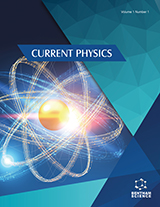Abstract
Background: Currently, some modern spectroscopic applications require sub-terahertz and terahertz continuous-wave electromagnetic radiation sources with power levels from 0.1 to 100 W. Gyrotron, a powerful high-frequency vacuum electronics device, is considered one of the promising sources for these aims.
Methods: Modification of the gyrotron design promotes the widespread use of these devices for DNP/NMR spectroscopy.
Results: Promising non-canonical concepts are presented, the features of which compare favorably with the classical gyrotron scheme.
Conclusion: The gyrotron concepts we considered allow us to master the terahertz range and develop a unique gyrotron installation for each scientific group, considering the specifics of their scientific research.
[http://dx.doi.org/10.1007/s11141-012-9326-8]
[http://dx.doi.org/10.1007/s10762-014-0050-7]
[http://dx.doi.org/10.1109/TTHZ.2015.2442836]
[http://dx.doi.org/10.1016/j.infrared.2016.01.015]
[http://dx.doi.org/10.1109/TPS.2017.2775678]
[http://dx.doi.org/10.1088/0022-3727/47/37/374001]
[http://dx.doi.org/10.3367/UFNe.2016.02.037801]
[http://dx.doi.org/10.3390/photonics10020189]
[http://dx.doi.org/10.1039/c003685b] [PMID: 20449524]
[http://dx.doi.org/10.1016/j.jmr.2019.07.019] [PMID: 31327537]
[http://dx.doi.org/10.1039/c003697h] [PMID: 20461255]
[http://dx.doi.org/10.1007/s11141-014-9456-2]
[http://dx.doi.org/10.1007/s11141-018-9888-1]
[http://dx.doi.org/10.1007/s10762-022-00845-7]
[http://dx.doi.org/10.1109/TED.2011.2148721]
[http://dx.doi.org/10.1109/TED.2015.2493563]
[http://dx.doi.org/10.1007/s10762-015-0161-9]
[http://dx.doi.org/10.1007/s10762-018-0522-2]
[http://dx.doi.org/10.1109/27.772260]
[http://dx.doi.org/10.1007/s11141-018-9905-4]
[http://dx.doi.org/10.1134/S0020441222020099]
[http://dx.doi.org/10.1063/1.5132831] [PMID: 31893824]
[http://dx.doi.org/10.1038/s41598-018-22772-1] [PMID: 29531359]
[http://dx.doi.org/10.1007/s11141-023-10202-w]
[http://dx.doi.org/10.1007/s10762-007-9215-y]
[http://dx.doi.org/10.1007/s10762-006-9084-9]
[http://dx.doi.org/10.52452/00213462_2021_64_04_265]
[http://dx.doi.org/10.1007/s11141-010-9222-z]
[http://dx.doi.org/10.1063/1.4921322] [PMID: 26026544]
[http://dx.doi.org/10.1109/LED.2021.3113022]
[http://dx.doi.org/10.1007/s11141-010-9173-4]
[http://dx.doi.org/10.1109/TED.2017.2764874]
[http://dx.doi.org/10.1007/BF02122392]
[http://dx.doi.org/10.1007/s11141-014-9527-4]
[http://dx.doi.org/10.1109/TPS.2004.829976]
[http://dx.doi.org/10.1109/TED.2020.2996179]
[http://dx.doi.org/10.1109/TED.2016.2629029]
[http://dx.doi.org/10.1109/LED.2020.3010445]
[http://dx.doi.org/10.1063/1.92369]
[http://dx.doi.org/10.1007/BF01057321]
[http://dx.doi.org/10.1063/1.5099909]
[http://dx.doi.org/10.1109/TED.2020.3039209]
[http://dx.doi.org/10.1109/TED.2021.3114141]
[http://dx.doi.org/10.1063/1.1656732]
[http://dx.doi.org/10.1109/TPS.2002.802151]
[http://dx.doi.org/10.1016/j.vacuum.2004.09.022]
[http://dx.doi.org/10.1007/s10762-006-9094-7]
[http://dx.doi.org/10.1007/s11141-009-9157-4]
[http://dx.doi.org/10.1103/PhysRevLett.102.245101] [PMID: 19659020]
[http://dx.doi.org/10.1063/1.5094875]
[http://dx.doi.org/10.1007/BF01039240]
[http://dx.doi.org/10.1007/BF01054034]
[http://dx.doi.org/10.1063/1.4997994] [PMID: 28964246]
[http://dx.doi.org/10.1109/27.772272]
[http://dx.doi.org/10.1007/s11141-020-10038-8]
[http://dx.doi.org/10.52452/00213462_2023_66_01_1]
[http://dx.doi.org/10.1109/TED.2020.3001491]
[http://dx.doi.org/10.1109/22.210224]
[http://dx.doi.org/10.1016/0168-9002(95)00609-5]
[http://dx.doi.org/10.1109/TPS.2004.828807]
[http://dx.doi.org/10.1088/0029-5515/47/12/009]
[http://dx.doi.org/10.1103/PhysRevLett.73.3532]
[http://dx.doi.org/10.1016/j.infrared.2018.03.024]
[http://dx.doi.org/10.1109/TPS.2017.2673550]
[http://dx.doi.org/10.3103/S1062873818120274]
[http://dx.doi.org/10.18500/0869-6632-2012-20-3-70-80]


















